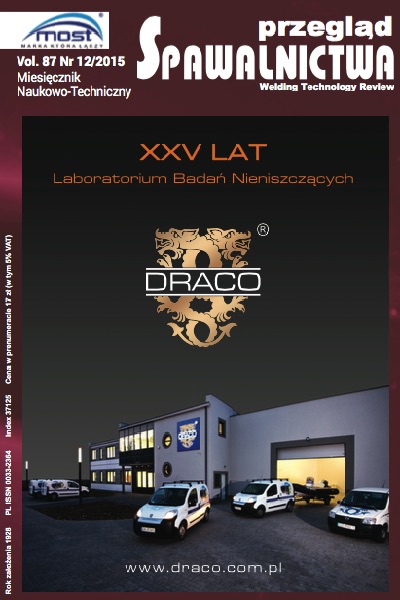Bezpośrednia diagnostyka kompozytowych elementów lotniczych z wykorzystaniem struktur inteligentnych
Main Article Content
Abstract
Zastosowanie fal sprężystych wzbudzonych w badanym elemencie za pomocą umieszczonej na nim sieci przetworników piezoelektrycznych jest jednym z obiecujących kierunków rozwoju technologii bezpośredniej diagnostyki struktur lotniczych (SHM). Możliwości systemów SHM są związane z dwoma różnymi ścieżkami rozwoju tej technologii, tj. zastosowanych rozwiązań technicznych, np. rodzaju przetworników PZT czy aparatury pomiarowej oraz metod analizy sygnału rejestrowanego przez przetworniki. Do pierwszej gałęzi rozwoju systemów SHM należy m.in. dobór optymalnego rodzaju przetworników PZT do danego zagadnienia oraz sposób ich związania z monitorowaną strukturą. W przypadku kompozytów, oprócz związania przetworników z badaną powierzchnią, możliwe jest również ich wbudowanie w wewnętrzną strukturę materiału. W artykule zaprezentowano przykład wykorzystania przetworników PZT wbudowanych w strukturę kompozytową do detekcji uszkodzeń udarowych BVID. Zaprezentowano algorytm lokalizacji uszkodzeń BVID oraz wyniki badań laboratoryjnych weryfikujących zaproponowane metody.
Self-diagnostics of composite aerospace structures with use of inteligent materials
Application of guided waves excited by a network of PZT transducers integrated with a given structure is one of the promising approaches to Structural Health Monitoring (SHM). The performance of SHM system based on PZT network is rooted in two distinct areas of the technology development, that is: the hardware and the signal analysis. The first includes is the type of transducers used to built a network and the way of their integration with a monitored structure. For composites, beside the possibility of the transducers attachment to a surface of an element, also embedding of PZTs into their internal structure is available. In the article Barely Visible Impact Damage (BVID) detection capabilitiy of the embedded PZT transducers is presented. An algorithm of damage localization is also proposed and verified in laboratory tests.
Downloads
Article Details
Creative Commons CC BY 4.0 https://creativecommons.org/licenses/by/4.0/
Welding Technology Review (WTR) articles are published open access under a CC BY licence (Creative Commons Attribution 4.0 International licence). The CC BY licence is the most open licence available and considered the industry 'gold standard' for open access; it is also preferred by many funders. This licence allows readers to copy and redistribute the material in any medium or format, and to alter, transform, or build upon the material, including for commercial use, providing the original author is credited.
References
Y. Kim, S. Sheehy, D. Lenhardt: A survey of Aircraft Structural-Li-Fe Management Programs in the U.S. Navy, the Canadian Forces, and the U.S. Air Force, RAND Corporation monograph series, 2006.
United States Department of Defence. MIL-HDBK-1823A: Nondestruc- tive evaluation system: reliability assessment, 2009.
C. Boller, W.J Staszewski: Aircraft structural health and usage monitoring. John Wiley and Sons, Ltd, 2004.
V. Giurgiutiu: Structural health monitoring: with piezoelectric wafer active sensors. Academic Press, 2007.
Z. Su, L. Ye: Identification of damage using lamb waves: from fundamentals to applications. Springer, 2009.
D. Adams: Health Monitoring of Structural Materials and Components: Methods with Applications. John Wiley and Sons, Ltd, 2007.
D. Roach: Industry survey of structural health monitoring technology and usage. Sandia National Laboratories, 2012.
L. Ilcewicz: CS&TA Federal Aviation Administration, 2006.
M. Dziendzikowski, K. Dragan, A. Kurnyta, S. Klysz, A. Leski: Damage Size Estimation of the Aircraft Structure with use of Embedded Sensor Network Generating Elastic Waves. Key Engineering Materials, 598: 57-62, 2014.
